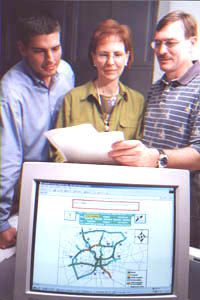UA Researchers Look at Ways of Untangling Traffic
by Bill Gerdes

A team of researchers at The University of Alabama thinks answers to traffic problems in Birmingham and other U.S. cities lie in today’s advanced technology, answers that will produce safer highways, less congestion, more efficient commuting, quicker emergency response, and fewer frayed nerves.
Dr. Michele Bunn and Dr. Grant Savage are on the faculty at UA’s Culverhouse College of Commerce and Business Administration. Bunn is an assistant professor of marketing and Savage is the Richard Scrushy/HealthSouth chair and professor of healthcare management.
Bunn and Savage have received two federal grants, through the University Transportation Center for Alabama, to fund their research. The grants total in excess of $333,000. Bunn said much of their research involved studying what other metropolitan areas are doing with an eye toward applying the best practices to the Birmingham area.
“In surveying the country for other incident management programs, we have found more than 40 places in which some sort of program is in place,” Bunn said. “Significant benefits have been reported in those areas where incident management systems have been installed. There is clearly a need for an Intelligent Transportation System in the Birmingham area,” she said.
Hal White, a second-year M.B.A. student, is the project manager for the research efforts.
“Typically, there are seven steps in an incident management system. The first, of course, is incident detection, the first report that there has been an accident,” White said.
“The next step is incident verification. You don’t want to send out false information.
“Third, there is the response to the incident, dispatching patrol cars and emergency medical units.
“Once the units are on-site, you have to manage the incident itself, then manage the resulting traffic problems.
“The sixth step is clearing the highway and the site, and the last step is assuring complete recovery of the traffic flow.”
In the best scenario, the incident management system would include an automatic collision notification device installed in vehicles that would activate when a collision occurs. An automatic wireless call would provide relevant crash data to the E-9-1-1 operator as well as to the nearest trauma center, and would plot the exact location of the crash on a computerized map at both locations.
The data being transmitted would indicate the severity of the crash and enable the E-9-1-1 operator to determine whether to send a patrol car for traffic control, ambulances, and/or the medi-vac helicopter. The same computerized map would allow the E-9-1-1 operator to locate the closest police car and the closest ambulance and fire trucks. The vision also includes cameras located along highways to allow a closer look at the problem. As emergency personnel transport victims to the trauma center, trauma teams would already know from the crash data the types of injuries to expect.
“Wireless users who subscribe to traffic data services would be notified immediately of the clogged traffic situation ahead and be offered alternate routes,” Savage said. The Internet could also be used in the system so commuters can check traffic flow before leaving their home, a system already in use in several areas such as San Antonio, Texas.
Bunn said the use of wireless telephones has been a concern for some.
“There is a concern about the privacy issue,” she said. “Some people feel like this is another form of Big Brother-ism, that integrating wireless phones into the system will allow authorities to keep track of where you are and where you have been. But there are several safeguards to keep that from happening.”
In addition to the multi-agency, multi-jurisdiction coordination needed with such a system, Bunn said funding a system for an urban area such as Birmingham would be a major concern. According to the World Road Association, installing ITS infrastructure in one large metropolitan area could cost as much as $420 million.”But with the increasing use of cellular phones and other technologies, as well as the intense concern over highway safety, we think the social and economic benefits of an integrated traffic management and crash response system more than justify the investment,” Bunn said.
One such program is in operation in Atlanta, where the average time needed to verify an incident went from 4.2 minutes to 1.1 minutes in the first three weeks of system operation. The average time between the time the incident was verified and the time the travel lanes were cleared dropped from 40.5 minutes to 24.9 minutes during the first three weeks, while the maximum time between verification and lane clearance dropped from 6.25 hours to 1.5 hours. There also was a significant benefit to cost ratio of 2.3:1.
Technology alone is not the answer, both Bunn and Savage stressed. “It is obvious that installing an efficient Intelligent Transportation System in an area such as metropolitan Birmingham will require the cooperation of many different agencies and governments,” Savage said. “There has to be a structured strategic planning process that involves all the players. But the benefits to the traveling public in terms of safety, time and gasoline savings can be tremendous.”
Contact
Whitney Taylor, Engineering Student Writer, 205/348-3051, wmtaylor@bama.ua.edu Mary Wymer, mwymer@eng.ua.edu